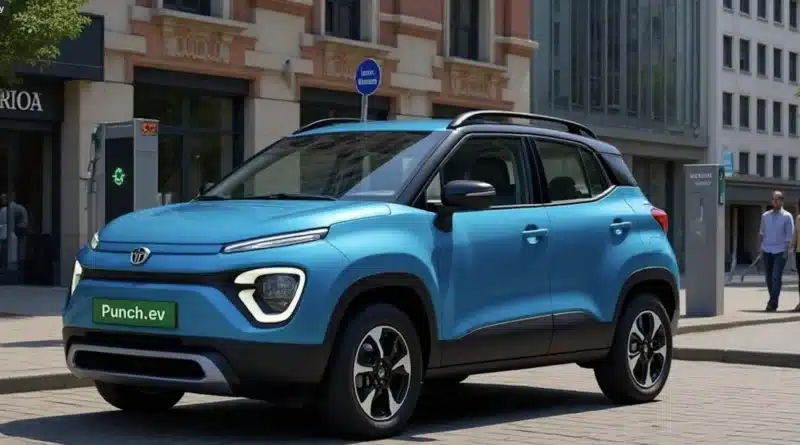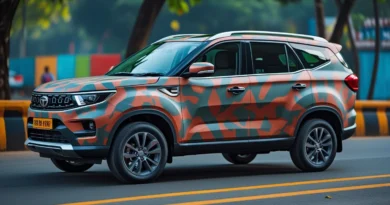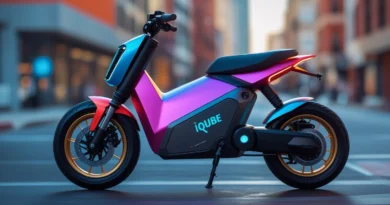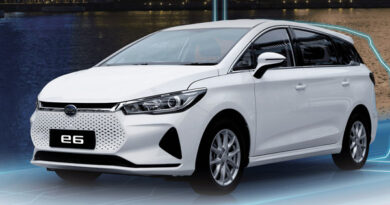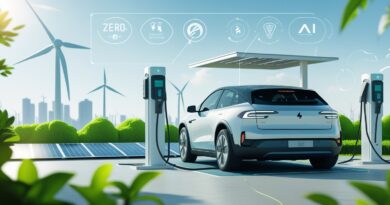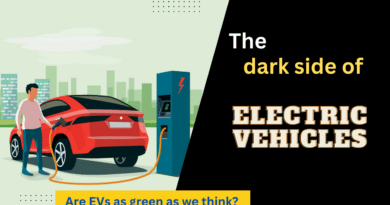The Tata Punch EV is a budget-friendly powerful electric SUV.
The Tata Punch EV, a daring all-electric SUV from Tata Motors, redefines value in the entry-level EV market. Built on the cutting-edge acti.ev architecture, it combines a lot of features, a practical range, powerful performance, and a clean design at a starting price around ₹10 lakh.
Table of Contents
Striking Design and Smart Packaging
Tata retains the Punch’s compact‑SUV silhouette but transforms its front fascia with a closed grille, full-width amber LED DRLs, and split headlamp assembly for an instantly electric identity. EV‑blue accents and aero‑optimized bumpers elevate its styling while unique alloy wheels ground the design in modernity. 
Thanks to the flat acti.ev skateboard floor, the Punch EV stretches slightly longer and taller than its ICE version. Its 366 litre boot plus a clever 14 litre “frunk” prove convenient for weekend trips. 
Powertrain and Driving Dynamics
The Punch EV offers two battery‑motor combinations. The 25 kWh standard variant delivers 81.5 PS (≈80 hp), 114 Nm torque, and an ARAI range of ~315 km. The 35 kWh long‑range version boosts power to 120 hp (≈122 PS), 190 Nm torque, and raises the claimed range to ~421 km. 
Tata claims the long‑range model accelerates from 0–100 km/h in just 9.5 seconds and tops out at 140 km/h. In real‑world use, drivers often report 280‑310 km range with the 35 kWh pack under mixed conditions. 
Charging and Regenerative Braking
The Punch EV includes a 3.3 kW onboard AC charger as standard. Upgrading to a 7.2 kW AC wall charger trims charge time to around 3.5 hours (25 kWh) or 5 hours (35 kWh). Public DC fast charging at up to 50 kW brings it from 10%–80% in roughly 56 minutes. 
Drivers can switch between four levels of regenerative braking (L0–L3) via paddle shifters. L3 maximizes recuperation for stop‑start urban driving. 
Interior Comfort and Features
The cabin impresses with a 10.25″ Harman touchscreen paired with a digital cluster, wireless phone charging, and air purifier. Upper trims offer ventilated front seats, cruise control, hill hold and descent functions, electronic parking brake with auto‑hold, and a 360° surround‑view camera system. 
However, the rear seat can feel tight for tall passengers, and rear USB ports or AC vents don’t feature across trims. 
Safety and Reliability
Tata equipped the Punch EV with six airbags, ABS with EBD, Electronic Stability Control, hill climb and descent assist, and blind‑spot view monitoring. The vehicle earned a 5‑star rating in BNCAP crash tests, scoring 31.46/32 for adult occupant protection and 45/49 for child safety.  
Real‑World Feedback and Ownership
Owners praise the Punch EV’s practicality, road manners, and low running cost. A spacious boot and composure over uneven surfaces win positive remarks. One long‑term reviewer managed a 150 km Pune trip with 44% battery left, topping up in around 67 minutes for just ₹345. 
Automotive reviewers highlight a firm‑tuned suspension, crisp handling, and commendable stability for a small SUV at highway speeds. Some minor niggles like absent cruise control glitches or missing spare tyre keep expectations realistic. 
Verdict
The Tata Punch EV emerges as an impressive and affordable electric SUV. It brings strong performance, cutting‑edge safety, and smart packaging to buyers who want bold styling and practicality without breaking the bank. For city dwellers, adventurers looking for short road trips, or first‑time EV buyers, it delivers value with very few compromises.
FAQs
The Tata Punch EV starts at around ₹10 lakh (ex-showroom), making it one of the most affordable all-electric SUVs in India.
There are two variants:
Standard (25 kWh): 81.5 PS power, 114 Nm torque, ~315 km ARAI range
Long-Range (35 kWh): 120 hp power, 190 Nm torque, ~421 km ARAI range
In real-world mixed driving conditions, the long-range 35 kWh version typically delivers 280–310 km on a full charge.
3.3 kW AC Charger: Standard option, longer charge time
7.2 kW AC Charger: ~3.5 hrs (25 kWh) or ~5 hrs (35 kWh)
DC Fast Charging (50 kW): 10%–80% in approx. 56 minutes
Yes, it offers four levels of regenerative braking (L0–L3) via paddle shifters, allowing energy recuperation and improved efficiency in city traffic.
The top trims include:
10.25″ Harman touchscreen with digital cluster
Wireless phone charging & air purifier
Ventilated seats, electronic parking brake with auto-hold
360° camera, hill hold/descent assist, cruise control (upper trims)
Yes, it earned a 5-star BNCAP rating, with:
31.46/32 for adult protection
45/49 for child safety
Key safety features:
6 airbags, ABS with EBD, ESC
Blind-spot monitoring, hill assist
Boot space: 366 litres
Frunk (front trunk): 14 litres
This provides ample room for weekend travel and city errands.
The long-range model accelerates 0–100 km/h in 9.5 seconds and maintains stability at speeds up to 140 km/h, offering firm suspension and confident highway manners.
Some minor limitations include:
Tight rear seating for tall passengers
Lack of rear AC vents or USB ports in certain trims
Occasional software glitches with cruise control
No spare tyre provided
Owners appreciate:
Low running costs (e.g., ₹345 for 150 km trip)
Composed ride over bumps
Functional boot and efficient charging
Some users report positive city and highway performance with manageable compromises.
Yes, it’s ideal for urban drivers, weekend explorers, and budget-conscious EV adopters. It balances performance, features, safety, and cost exceptionally well.

